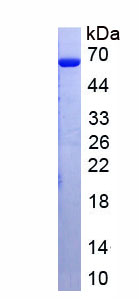Active Telomerase Reverse Transcriptase (TERT) 

EST2; TCS1; TP2; TRT; hEST2; Telomerase catalytic subunit; Telomerase-associated protein 2
Overview
Properties
- Product No.APC241Hu01
- Organism SpeciesHomo sapiens (Human) Same name, Different species.
- ApplicationsCell culture; Activity Assays.
Research use only - DownloadInstruction Manual
- CategoryEnzyme & KinaseTumor immunityDevelopmental scienceGenetic science
- Buffer FormulationPBS, pH7.4, containing 0.01% SKL, 5% Trehalose.
- Traits Freeze-dried powder, Purity > 90%
- Isoelectric Point8.8
Sign into your account
Share a new citation as an author
Upload your experimental result
Review

Contact us
Please fill in the blank.
Activity test

Telomerase reverse transcriptase (TERT) is a subunit of the enzyme complex telomerase, which adds nucleotides to the ends of telomeres as they become shortened during cell division .Telomerase complex plays a key role in cancer formation by telomere dependent or independent mechanisms. According to statistics, human telomerase reverse transcriptase (h-TERT) is overexpressed in more than 85% of tumors with diverse histologies, with little expression in normal tissues. Expression of h-TERT correlates with activity of telomerase, which is required for the capacity for limitless replication, a hallmark of cancer. The X-Ray Repair Cross Complementing 6 (XRCC6) is high affinity receptor for TERT, thus a functional binding ELISA assay was conducted to detect the interaction of recombinant human TERT and recombinant rat XRCC6. Briefly, TERT was diluted serially in PBS with 0.01% BSA (pH 7.4). Duplicate samples of 100 μl were then transferred to XRCC6-coated microtiter wells and incubated for 1h at 37℃. Wells were washed with PBST and incubated for 1h with anti-TERT pAb, then aspirated and washed 3 times. After incubation with HRP labelled secondary antibody for 1h at 37℃, wells were aspirated and washed 5 times. With the addition of substrate solution, wells were incubated 15-25 minutes at 37℃. Finally, add 50 µL stop solution to the wells and read at 450/630 nm immediately. The binding activity of recombinant TERT and recombinant rat XRCC6 was shown in Figure 1, the EC50 for this effect is 0.009 ug/mL.
Usage
Reconstitute in 10mM PBS (pH7.4) to a concentration of 0.1-1.0 mg/mL. Do not vortex.
Storage
Avoid repeated freeze/thaw cycles. Store at 2-8°C for one month. Aliquot and store at -80°C for 12 months.
Stability
The thermal stability is described by the loss rate. The loss rate was determined by accelerated thermal degradation test, that is, incubate the protein at 37°C for 48h, and no obvious degradation and precipitation were observed. The loss rate is less than 5% within the expiration date under appropriate storage condition.
Increment services
-
 BCA Protein Quantification Kit
BCA Protein Quantification Kit
-
 Molecular Mass Marker for Protein
Molecular Mass Marker for Protein
-
 Monoclonal Antibody Customized Service
Monoclonal Antibody Customized Service
-
 Polyclonal Antibody Customized Service
Polyclonal Antibody Customized Service
-
 Protein Activity Test Experiment Service
Protein Activity Test Experiment Service
-
 Electrophoretic Mobility Shift Assay (EMSA) Experiment Service
Electrophoretic Mobility Shift Assay (EMSA) Experiment Service
-
 Buffer
Buffer
-
 Lentivirus Packaging Experiment Service
Lentivirus Packaging Experiment Service
-
 Adenovirus Packaging Experiment Service
Adenovirus Packaging Experiment Service
-
 Real Time PCR Experimental Service
Real Time PCR Experimental Service
-
 Spike RBD Protein (S-RBD)
Spike RBD Protein (S-RBD)
-
 Protein G
Protein G
-
 Protein A
Protein A
Citations
- Telomeres are elongated in rats exposed to moderate altitudePubmed:Pmc4088304
- Thymocytes maintain immune activity through telomere elongation in rats under hypoxic conditionsPubMed: 26640565
- Telomere elongation protects heart and lung tissue cells from fatal damage in rats exposed to severe hypoxiaPubmed:29454386
- Coexistence of obstructive sleep apnea and telomerase activity, concentration of selected adipose tissue hormones and vascular endothelial function in patients with …
- Maternal neglect results in reduced telomerase activity and increased oxidative load in ratsPubmed: 32588701
- Reversal of brain aging by targeting telomerase: A nutraceutical approach34515324







